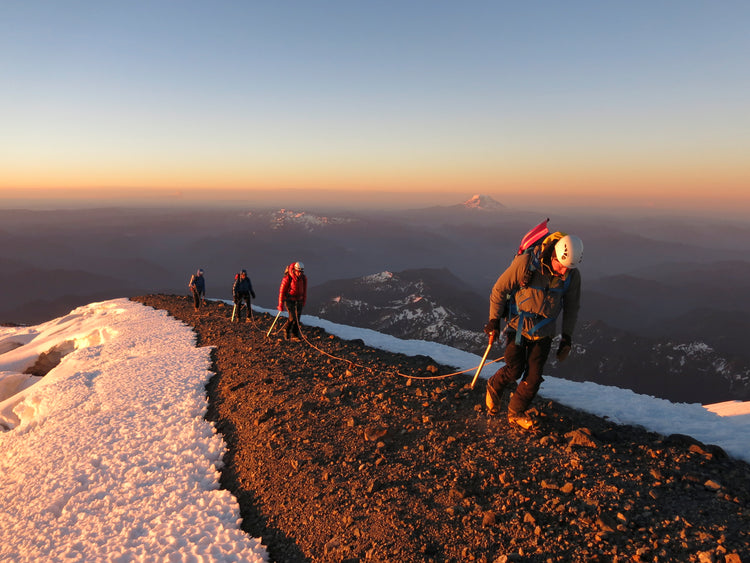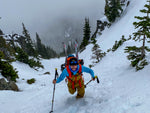This post is a repurposed version of a post at our sister company, RMI Expeditions. Find it here.
Recap: Creating your Training Program
This is part 2 of a 2 part series: for a guide on how to create a training program, click here.
In our last article, we talked about what the guides over at our sister company RMI recommend when planning a mountaineering training program. We ended by taking a look at what a general weekly schedule should look like.
A general weekly schedule follows:

Part 1: Cardiovascular Fitness
Cardiovascular training uses both aerobic exercises and interval training and functions as the foundation for your ability to climb for long periods of time.
Aerobic Training
A variety of aerobic exercises work well for training, including climbing and descending hills, stairs or stadium bleachers, skiing, running, and cycling. Build your aerobic training over time, beginning with shorter sessions and increasing to longer workouts. By the time your climb approaches you should feel comfortable with an aerobic exertion that is similar to any day of your anticipated climb. Don’t forget to prepare for the downhills too by training on varied terrain and developing your aerobic ability for the descent.
Of course, in order to train for the exhausting days in the mountains, you’ve got to get out and do lengthy training climbs; nothing else will prepare you as adequately.
The frequency of your aerobic workout is fairly unlimited. Train every day if you like, but don’t overdo it and end up with injuries. Include some rest time each week.
A well-known formula for determining your maximum heart rate is based on your age: subtract your age from the number 220 (beats per minute). For example, a 39 year old has a maximum heart rate of 181; i.e., 220 - 39 = 181 beats per minute. The training range, then, is between 118 and 154 beats per minute. This is arbitrary at best and we suggest that you begin with that formula but be aware of how you feel. Your perceived exertion usually serves as a better indicator of how you ought to be performing on a given day. We have good days and bad days such that “how we feel” should come into play.
Recommendations
At least 30 minutes of aerobic training per session.
Keep your training range at 65 to 85% of your maximum heart rate. Subtract your age from the number 220 (beats per minute).
Interval Training
Interval training is an important component in improving your cardiovascular base and preparing to climb comfortably at a variety of paces. The technique of interval training calls for including surges in activity while maintaining an elevated heart rate. Interval training, used over a long period of time, can increase the heart’s capacity for pumping blood through the body. We have had success with interval training when we have a minimum of three months of training time.
Recommendations
5-minute running intervals, 30-minute time trials riding a bike, or Speed hikes lasting up to an hour.
Part 2: Motor Fitness
Motor fitness training develops the endurance, strength, power, balance, agility and flexibility to climb efficiently on steep and challenging terrain.
Endurance Training
Endurance is a motor skill like strength and balance and can be developed with training. In short, endurance training is a focus on continually increasing the intensity of your training and not becoming complacent in your routine or your level of fitness. This will build a more durable body and allow you to climb strongly for an extended period of time as well as adapt to the unanticipated physical challenges of the climb.
Recommendations
Increasing the weight carried in your pack, performing your aerobic exercises for longer distances, maintaining your interval efforts for longer periods of time, pushing yourself to run or hike your favorite loop in a shorter period of time, increasing the weight or repetitions in your strength training, or making your balance exercises more challenging.
Strength and Power Training
In addition to leg strength, mountaineering requires a strong core (back and stomach) as heavy pack weights add a new dimension to climbing. Strength training principles are essentially the same for upper and lower bodies. Strength training can involve body weight exercises as well as routines using traditional weights.
Recommendations
Squats, lunges, and leg presses. Push-ups, pull-ups, and military presses. Sit-ups and abdominal exercises.
Balance and Agility Training
Balance exercises give you increased body awareness and aid in your ability to negotiate tricky terrain under a heavy pack. Balance is a motor skill and can be improved over time. Distinguish between static and dynamic balance exercises. Static exercises will keep one or both feet on the ground. Dynamic exercises involve the body in motion. Both are important for the development of this fitness skill.
Recommendations
Static
Standing on one leg, standing on one leg with eyes closed.
Dynamic
Walking a line (with and without eyes closed), walking on an elevated rope (slacklining).
Stretching Exercises
Stretching helps reduce muscular tension and increases flexibility. With static stretching, don’t stretch through pain; you are stretching and tearing muscle fibers with this activity. Improper stretching can lead to injury and disillusionment with this aspect of motor fitness training
Recommendations
Focus on slow, static stretching and hold the stretch for 30 to 60 seconds, breathing through the stretch. Hold it only to the point of tension. Stretch all parts of your body, not only your legs. Carrying a heavy pack often puts unexpected strain on your neck, shoulders, and back in addition to fatiguing your legs.
Congratulations, you now have one of the best Mountain Training Plans out there!
RMI has led thousands of clients up the worlds top summits, and knows a thing or two about training for a climb. While this regimen isn’t guaranteed to make you summit, it will definitely increase your odds.
Until next time,
Happy Climbing!








